Codling moth
Codling moth, Cydia pomonella, is the principal insect pest of pome fruit in Victoria. The larvae (caterpillars) need to feed on fruit to survive to maturity. They are highly dependent on fruits as a food source and thus have a significant impact on crops. If not controlled almost the entire crop can be affected.
Control of codling moth is the key to almost all other pest programs in pome fruit orchards. Some of the chemicals registered to control codling moth have adverse effects on beneficial insect species, which contribute to biological control of other pests. Use of such disruptive chemicals often results in the need to apply more pesticides for control of minor pests.
Life stages
The adult codling moth has a wingspan of about 12 to 18 mm and is about 10 mm long when at rest with the wings folded. Females (Figure 1) are larger than males (Figure 2). The forewings are brownish grey with several grey crosslines. An iridescent coppery-brown spot is present near the tip of each forewing. The hind wings are pale brownish grey with fringed borders. At rest the codling moth has its wings folded behind its back (Figure 3).
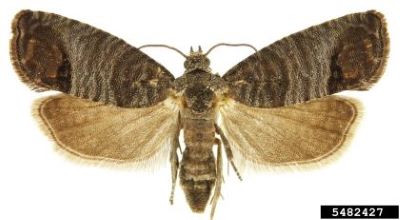
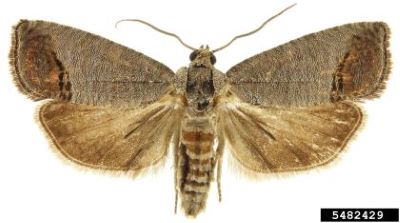

The female moth lays eggs singly on leaves and fruit. Each egg is flat, oval, one mm long, opaquely white when first laid then developing a red ring towards maturity. Just before hatching the black head of the larva becomes visible in the egg (Figure 4).
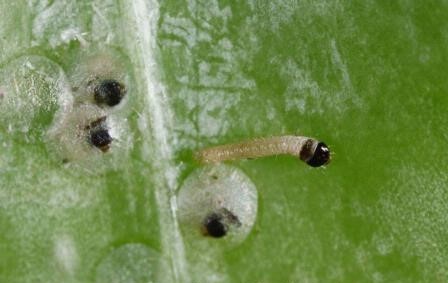
A newly hatched larva is white with a black head (Figure 4). There are generally five larval stages, which can be identified by the width of the head. Average widths of larval head for the five stages are approximately 0.3, 0.5, 0.8, 1.2 and 1.7 mm respectively.
Fully mature larvae are about 15 mm long and creamy pink with a dark brown head. They leave the fruit and form cocoons under loose bark on the tree or amongst leaf litter on the ground beneath the tree.
Seasonal development
In summer cocooned larvae form pupae from which the adult moth emerges about two weeks later. A small percentage of the cocooned larvae in summer enter diapause (become dormant) until the following spring. As daylength decreases higher and higher percentages of cocooned larvae enter diapause until autumn when they all enter diapause.
Over-wintering larvae start to pupate early in spring around the time of bloom as temperatures increase. The moths emerge usually in one or more periods of peak activity, each period referred to as a 'flight'. A second cohort of the over-wintered population pupates later when the daylength increases to around 14 hours. Up to three generations per season may occur in Victoria, depending on prevailing weather conditions.
Injury
Young larvae chew through the fruit skin and excavate a cavity where they moult before starting to bore their way to the core to feed on seeds (Figure 5). The presence of one or more holes in fruit plugged with frass (excrement) is characteristic of attack by codling moth (Figure 6). The larvae enter the fruit through the sides, stem or calyx end and a syrupy substance may exude from the holes as the fruit matures. Similar damage can be caused by Oriental Fruit Moth, but this species does not generally feed on seeds.
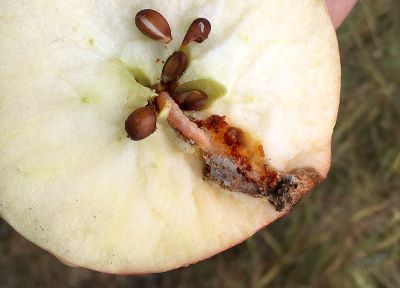
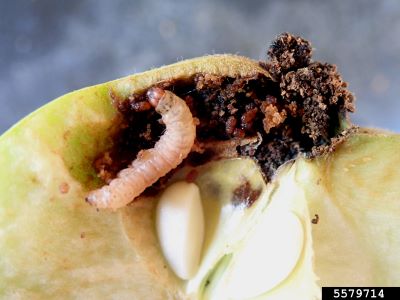
Shallow entries called 'stings' result when larvae die, often from insecticide poisoning, while excavating the cavity below the skin (Figure 7).

Effect of temperature
Insect growth rate accelerates as temperature increases until the optimum temperature for the particular insect is exceeded, at which point the growth rate rapidly declines. The temperature below which the growth of a given type of insect is called the lower developmental threshold.
The lower developmental threshold for codling moth is 10°C. The eggs, larvae and pupae of codling moth each have specific physiological time requirements to complete development before they transform to the next stage. Temperature also affects the flight, mating and egg laying activities of the adults. Male moths do not fly until temperatures exceed 13°C and codling moths do not mate until temperatures exceed 16°C.
Control options
Pheromone traps
Adult female codling moths release a sex-attractant chemical (pheromone) to attract male codling moths. Synthetic pheromones are used in traps to indicate the presence of male codling moths in orchards. Pheromone trap catches and temperature records can be used to predict when the eggs resulting from a particular moth flight will be hatching. Such predictions allow better timing of spraying. Traps containing a combination of pheromone and host plant volatiles are also available and attract both sexes, which is useful for monitoring moth activity when mating disruption products are in use.
Mating disruption is a technique in which the orchard air is saturated with pheromone emitted from slow-release dispensers. This upsets moth communication, making it difficult for male moths to locate females. Mating disruption products are available commercially for large-scale orchards and, although not entirely eliminating mating, are able to delay it and reduce the number of eggs being laid.
Biological control
Codling moth eggs are preyed on by earwigs and mirid bugs but neither gives significant control. Wasps such as Trichogramma parasitise codling moth eggs and have been used with some success in Russia. Under Australian conditions, the rate of parasitism is too low for commercial use as a stand-alone treatment but research is underway to integrate egg parasitism with other biological control options.
A parasitoid wasp, Mastrus ridens, that attacks codling moth larvae in their cocoons has been introduced and released into commercial orchards with promising results. This wasp is particularly effective at reducing overwintering populations of cocooned larvae. Also available commercially is a parasitic nematode that has similarly shown promise for control of over-wintering larvae.
Stressed codling moth larvae are susceptible to infection by a commercially available virus. Timing of application is critical. The larvae must ingest the virus and the only time they can be exposed is when they hatch from the egg and walk across a treated leaf or fruit surface on their way to a feeding site. It usually takes several seasons of persistent use, often in combination with other treatments, to bring the codling moth population levels down.
Cultural control
Removal of over-wintering sites by scraping loose bark from trees and maintenance of general orchard hygiene may help to reduce the survival of over-wintering populations. Similarly, provision of artificial cocooning sites such as bands of cloth or corrugated cardboard wrapped around the trunks allows over-wintering larvae to be trapped and destroyed. If not done properly, however, enhanced survival of overwintering larvae can occur. These methods are generally too time-consuming and expensive for adoption by commercial growers.
Chemical control
Chemical control is often used on plant pests as part of an Integrated Pest Management (IPM) program. Your local nursery, cropping consultant, chemical reseller or pesticide manufacturer will be able to advise you on the insecticide most suitable to your conditions. For information on currently registered and permitted chemicals, check the Australian Pesticide and Veterinary Medicine Authority (APVMA) website. Always consult the label and Safety Data Sheet before using any chemical product.
Image credits
- Figures 1 and 2 Todd M Gilligan and Marc E Epstein TortAI Tortricids of Agricultural Importance. USDA APHIS PPQ Bugwood.org
- Figure 3 Whitney Cranshaw, Colorado State University, Bugwood.org
- Figure 4 Jack Kelly Clark. Used with permission of the University of California Statewide IPM Program
- Figure 5 Ross Courtney, Good Fruit Grower
- Figure 6 Whitney Cranshaw, Colorado State University, Bugwood.org
- Figure 7 Ward Upham, Kansas State University, Bugwood.org
Reporting an unusual plant insect pest or disease
Report any unusual plant pest or disease immediately using our online reporting form or by calling the Exotic Plant Pest Hotline on 1800 084 881. Early reporting increases the chance of effective control and eradication.
Please take multiple good quality photos of the pests or damage to include in your report where possible, as this is essential for rapid pest and disease diagnosis and response.
Your report will be responded to by an experienced staff member, who may seek more information about the detection and explain next steps.
Report online